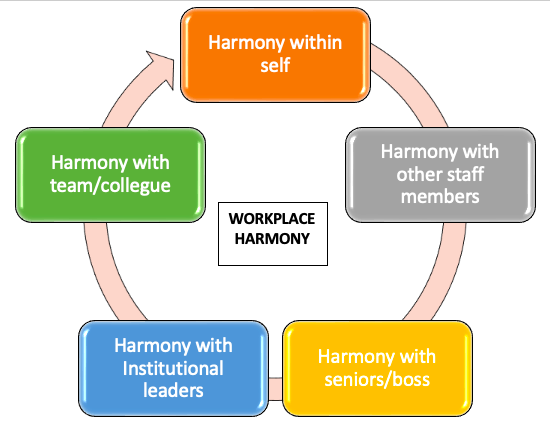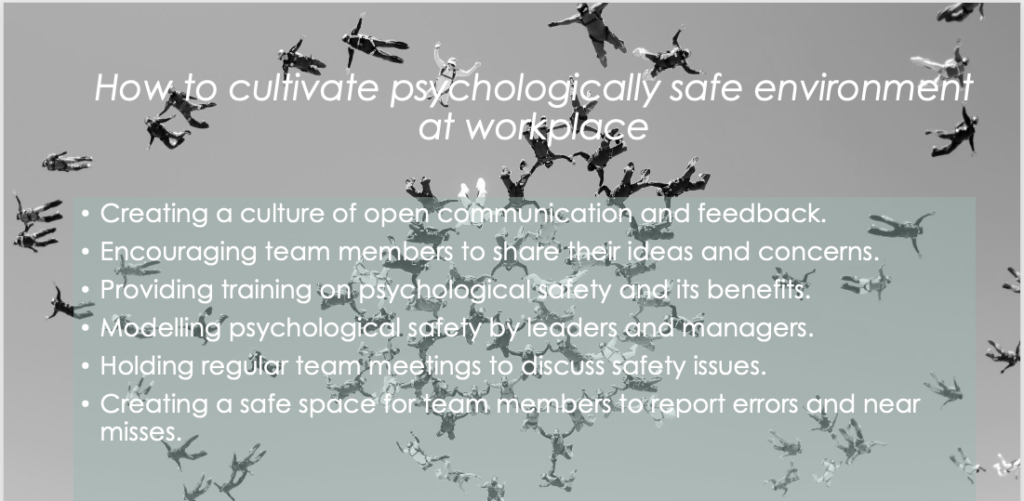
Volume 13 Issues 4 April, 2023
Health professionals spend a significant amount of time at the workplace, and any disturbance and disharmony at workplace affect their mental health. Workplace disharmony not only restricted to workers but also potentially affects patient care and quality of training and teaching too. It is pertinent to understand how to cultivate a psychologically safe and harmonious work environment for all.
A workplace is the place where we work, perform our duties, play a role, provide service to society, and care for patients under certain terms and conditions of the institute with ethical and moral responsibilities.
A health care organization is a multidisciplinary, multi-professionals’ hierarchical organization where all sections work closely in best of their coordination. Workplace violence and harassment in the health sectors caught in limelight for some time globally, World Health Organization (WHO) stated that at least 8% to 38% of health care providers faces any form of violence at work in their lifetime. Here, we try to understand the technical part of violence and harassment in health sectors.

Workplace Harassment denotes a form of discrimination that comprises of any unwanted and unwelcome physical or verbal behaviour which can easily offend or humiliate a person. There behaviours should be upsetting, threatening, or disturbing and are on discriminatory grounds for legal precedence. Harassment not only prevent an individual from getting benefit of his/her rights, but can be termed as bullying if happens repeatedly. To be more precise, first the conduct needs to be unwelcome or unwanted and offensive to the employee, second the said employee raised his/ her objection to it, third, employee allow the offend to revise his/her behaviour, lastly, the said conduct or the act must be of such a nature that draws an impact on the employee’s ability to carry out his/ her duties in an efficient, efficacious, and responsible manner. There are following types of harassments
1. Discriminatory harassment: based on discrimination like race, gender, religion, age, cast, regionality, language etc.
2. Personal harassment: not illegal but can cause psychological damage: Jokes, inappropriate comments, humiliation, and intimidation.
3. Physical harassment: Physical attack, threats, and physical assault also known as violence.
4. Power harassment: Any use of power beyond its purpose or with a malicious intent or for any personal interest can be labelled as misuse of the power.The usually, repeated threat, tricking or forcing employee for work beyond purview of their duties, or for personal work, beholding critical information, blaming subordinate for their own lack of competencies, endorsing rules with discrimination, putting personal interest before the departmental or institutional interest, condescending employee concerns are few common powers abuse.
5. Psychological harassment: Any damage to a person’s psychological well-being often creates a domino effect, leading to physical health issues, and therefore, psychological harassment deserves attention.
6. Cyberbullying: Cyberbullying is using technology to harass, threaten, embarrass, or target another person. Online threats and mean, aggressive, or rude texts, tweets, posts, or messages all count. So does posting personal information, pictures, or videos designed to hurt or embarrass someone.
7. Sexual harassment: any invasion of personal space in a sexual way, inappropriate sexual gesture, touch, comments, remark, or sharing of photo or video with sexual content can be included under sexual harassment.
Following are the main legal closes related to workplace harassment.
1. Prevention, prohibition, and redressal (PoSH) Act 2013.
- Obscene Acts and Songs under Section 294
- Assault or Criminal Force to Woman with an Intent to Outrage her Modesty under Section 354
- Sexual Harassment and Punishment for Sexual Harassment under section 354A
- Word, Gesture, or Act Intended to Insult the Modesty of a Woman under section 509
Before going to workplace harmony, we should also understand psychological safety, no reports, or objections or silence at workplace does mean harmony always. The employee also should feel psychological safe, enthusiasm of work, pride of belong to organisation, hence psychologically safely and work harmony goes hand in hand.
Psychological safety important factor in creating a positive and productive work environment in hospital settings. By promoting psychological safety, healthcare organizations can improve patient safety, communication, and collaboration and reduce stress and burnout among their employees. A culture of open discussion, communication, and liberty to raise concerns with prompt action to is crucial to psychological safety. Moreover, timely encouragement, a fair distribution of responsibilities, and equality encourage safety and even enhance work harmony (picture).
Workplace Harmony: The term harmony means agreement in feeling, opinion or accord. It is a pleasing combination of elements of a system to form an all-inclusive, all involving and more productive team.

Altruism and resilience also play important roles in establishing and sustaining workplace harmony. Pure altruism is selfless help for the benefit of others, which creates a compassionate employee friendly environment where they feel involved emotionally and drown in gratitude and satisfaction from their work. However, favouritism, i.e., helping colleagues for wasted interest and nepotism, i.e., helping their blood relatives or near and dear one be should discouraged. The term toxicity at the workplace commonly used during conversations for a psychological unsafe, insecurity, snitcher habits of colleagues, and frequent threats by the boss or HODs used for such workplace. Encouraging discipline, transparency, open communication, equality, unbiased implication of policies reduces so-called toxicity in the workplace.
Resilience is one ability to maintain psychological and emotional well-being while confronting various stressors, setbacks, and changes. Resilience empowers individuals to navigate the often challenging landscape of professional environments. Resilient employees are remarkably able to adapt to unexpected situations, bounce back from failures, and remain focused on their goals despite adversities. In short, harnessing the potential of a team members is an art; an environment of Mutual understanding, mutual respect, and coexistence need to be cultivated, self honesty, and others are the best policy in the workplace.

May I have information on the topic of your article?